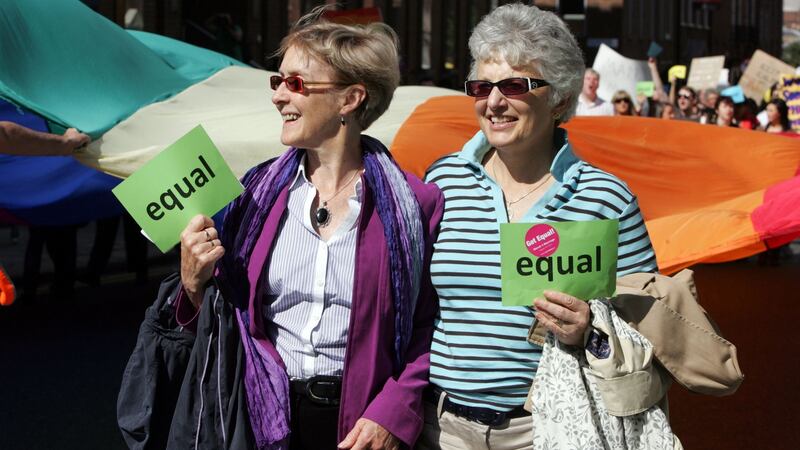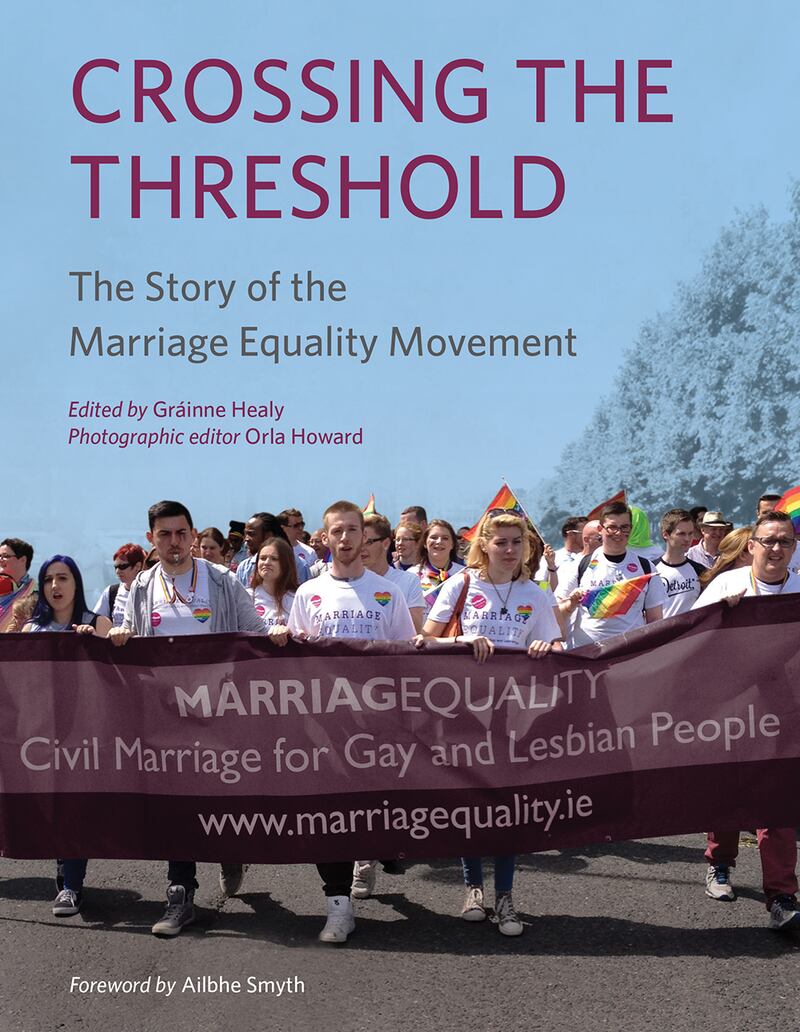Marriage Equality, the organisation set up over a decade ago to achieve civil marriage rights for same sex couples, packs up its tent in the coming weeks.
There are, however, two legacy publications in the pipeline: one a book edited by ME chairwoman Grainne Healy and the other a documentary film, The 34th, referring to the 34th amendment to the Constitution that was the marriage equality referendum, made by awardwinning production company Coco Television.
The book, Crossing the Threshold, is a “fusion of horizons”, a history of sorts that features contributions from leading marriage equality campaigners. It covers the political and the personal efforts and sacrifices that drove these leaders to campaign. As editor, my job was not to force consensus of opinion on the journey, but rather to encourage contributors to speak their versions of the lived realities they experienced as they worked towards marriage equality over many years.
The contributions from board members, staff members and some of those from other allied organisations on the journey provide the reader with a sense of the roads taken to achieve marriage equality and are not meant to be a definitive or final version of events, but rather a snapshot of some of the versions of how it all happened – that win in May 2015.

A colourful publication with more than 200 photographs chosen by photographic editor Orla Howard, the first chapter is fittingly from the two women who lit the spark and set the marriage equality campaign alight in Ireland, Katherine Zappone (now Minister for Children and Youth Affairs) and her beloved wife Ann Louise Gilligan.
Their love story has inspired a movement and more poignantly reminds us of the recent passing of Ann Louise Gilligan so soon after the victory they envisioned. They speak of the campaign as a “longing for a different Ireland … that fuelled hope for a more equal country for all”.
Andrew Hyland, communications director and co-director of Marriage Equality, devised the communications strategies used in the early campaign – central were the visibility of LGBT couples and the use of personal stories. The same strategies were core in the Yes Equality campaign which won the hearts and minds of “the million in the middle”.
Former director of Marriage Equality, Moninne Griffith, describes the strategy to win over TDs and Senators in the lead up to the referendum – the “Out to Your TD” campaign which brought into TDs’ clinics people explaining the importance of securing marriage equality.
Board members of Marriage Equality give their perspectives on the movement’s journey – Justine Schonfeld-Quinn details the KAL case (the High Court case taken by Katherine and Ann Louise to have their Canadian marriage recognised in Ireland). Anna MacCarthy tells how LGBT Noise formed and organised the annual march for marriage in Dublin. Olivia McEvoy describes the longtime partnership between Marriage Equality and the National Lesbian and Gay Federation (now NXF). Ronan Farren details the role of the Labour Party and in particular the efforts of former Labour Party leader Eamon Gilmore in pushing the issue to the fore.
Ross Golden Bannon tells of some of the less positive experiences he had while canvassing for a Yes and Anthony Kinahan from Louth Marriage Equality describes some of the encounters he had with those who opposed the extension of the civil right to marry for LGBT people.

Key partners and alliances are represented in the book including Kate Moynihan from Lesbians in Cork (LinC), Laura Harmon of USI (Union of Students in Ireland), Michael Barron of BelongTo and Richard O’Leary, who tells an at times poignant and funny tale of his YesVena and pilgrimage around Ireland as part of Faith in Marriage Equality (FIME) which includes a visit to both Lough Derg and Father Ted’s House!
Strategic differences between GLEN and Marriage Equality are mentioned by some authors and Brian Sheehan and Kieran Rose put forth their views on how GLEN took the path to marriage equality via Civil Partnership, a path not always appreciated by the broader LGBT movement.
My own contribution attempts to answer the question asked mostly by those not from Ireland, and by some who are: where did that 62 per cent vote come from? What were the socio-political changes that created the context for marriage equality in Ireland? While Marriage Equality co-founder Denise Charlton and her partner Paula Fagan outline the importance of family and children to the Marriage Equality analysis as it sought to win over hearts and minds.
The second legacy product from Marriage Equality is the work of Linda Cullen and Coco Television who have completed a documentary film The 34th: the story of marriage equality, a documentary depicting the key players from the organisation Marriage Equality, who led the movement for many years prior to joining with Irish Council for Civil Liberties and the Gay and Lesbian Equality Network (GLEN) to form the Yes Equality campaign. The film opened this year’s 25th anniversary GAZE festival at The Lighthouse, Dublin, on August 3rd and Culllen’s contribution in the book depicts the other effective videos and short films in which she was involved over the lifetime of Marriage Equality. Both these products are hugely significant in an effort to capture first hand the version of history making by the history makers!
Crossing The Threshold the Story of the Marriage Equality Movement, edited by Grainne Healy and photographic editor Orla Howard, is published by Merrion Press, at €24.99. Dr Gráinne Healy is co-founder and chairwoman of Marriage Equality, former co-director of the Yes Equality campaign and co- author of ‘Ireland Says Yes’ (Healy, Sheehan, Whelan, 2016)

















